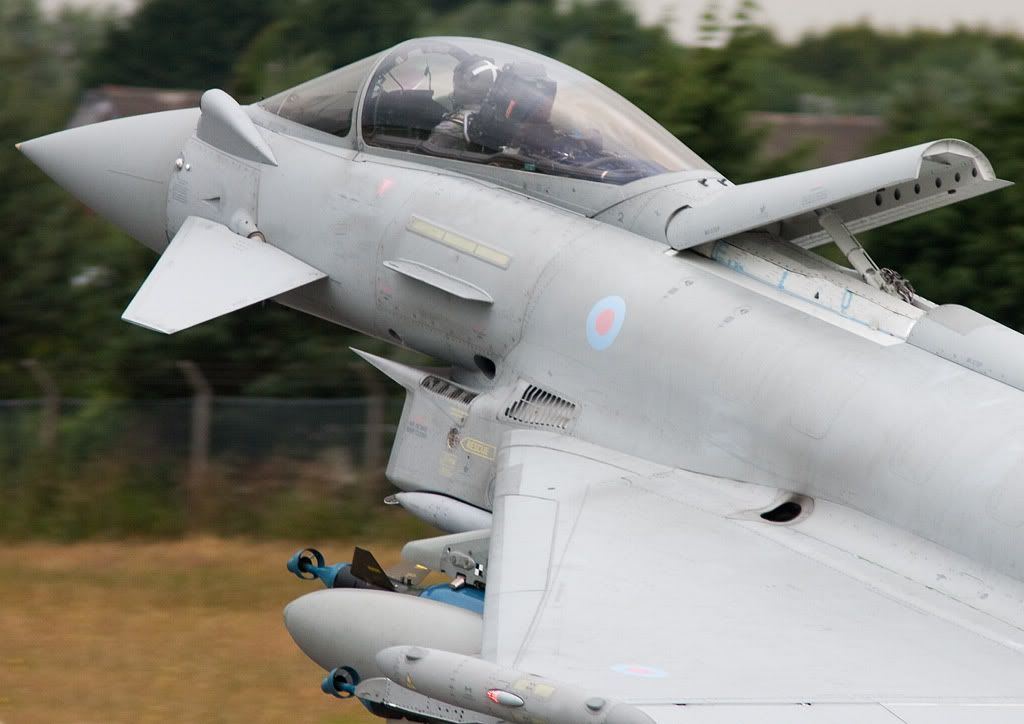SITUACIÓN DE PARTIDA DE ESPAÑA EN EL C.16
El salto tecnológico desde el C.15 (Hornet) al C.16 (Typhoon), siendo importante, resulta asequible para España al disponer de una amplia capacidad de Ingeniería para el C.15. Las otras naciones del Programa (Alemania, Italia y Reino Unido) no parten de una posición tan favorable, pues todas ellas han saltado de la tercera a la quinta generación (NOTA: aqui ponen al EFA de quinta. Pero vamos, no nos obcequemos: sea cuarta o quinta, es un salto cualitativo (tecnologico, generacional) importante).
Por otra parte, la industria española ha participado en el diseño, desarrollo y producción del sistema de armas. Si bien esta participación es limitada, en línea con el número de plataformas adquiridas (el 13% del total), está muy por encima de situaciones anteriores, en las que se adquiría un sistema de armas totalmente desarrollado y en servicio en otras Fuerzas Aéreas, y facilita adquirir conocimientos en áreas que no son responsabilidad de EADS–CASA o ITP. Otras industrias españolas han participado en el programa como subcontratistas, ampliando la base de ingeniería existente.
EL PROGRAMA INTERNACIONAL
El EF2000 es un programa internacional en el que se han repartido las tareas de todas las fases (diseño, desarrollo y demostración; producción; apoyo logístico) entre las industrias de las naciones participantes. Ninguna de ellas dispone inicialmente del 100% de la capacidad.
Actualmente, el apoyo de ingeniería se basa en una estructura internacional, conocida como International Weapons System Support System (IWSSS). Esta estructura consta de los equipos de Ingeniería de las cuatro industrias que forman el consorcio Eurofighter y de los cuatro centros de apoyo de ingeniería orgánicos (National Support Centres, NSC).
En España el NSC (National Support Centres) se llama NSO (National Support Organisation).
El segundo elemento principal de la NSO es el CLAEX. A nadie se le escapa que, a partir de la cuarta generación de aviones de combate, la modificación del software de a bordo y de determinados equipos de apoyo en tierra permite aumentar de forma espectacular y relativamente económica la operatividad de los sistemas de armas.
La creación del Centro de Apoyo al Software del C.15, que se convirtió después en el actual Grupo de Software Aeronáutico del CLAEX y asumió el apoyo a los sistemas de armas modernizados (C.14M y AE.9M), fue una apuesta decidida que ha dado sus frutos y permite afrontar con garantías el desafío que supone el C.16.
Existen oficiales (españoles) ingenieros en el extranjero, contribuyendo a la adquisición de conocimientos sobre el sistema de armas. Dos de ellos están en el SUZ (System Support Centre) aleman, el centro nacional más avanzado y mejor dotado de medios en la actualidad. Estos oficiales están integrados en la estructura del SUZ y colaboran en la resolución de problemas, planteados tanto por el Ejército del Aire como por la Luftwaffe.
Hay también un oficial ingeniero en la Base Aérea de Laage (Alemania) y se ha iniciado el proceso para que otro oficial ingeniero se integre en la Base Aérea de Coningsby (Reino Unido).
Se ha contratado un banco de aviónica, similar a los existentes para el C.15, AE.9 y C.14, que se instalará en el CLAEX.
Esta estructura ha permitido que a mediados de 2007 se hayan realizado más de 11.000 actuaciones en el área de apoyo de ingeniería. Pero lo más importante son los resultados: se ha reducido el tiempo de recuperación en 30 minutos; se han resuelto 90 situaciones de aviones fuera de servicio por falta de repuestos, gracias a una adecuada gestión de flota; y en 20 inspecciones programadas se ha ampliado el tiempo entre inspecciones.
EL FUTURO
Estos resultados no pueden hacernos caer en la complacencia. El Ejército del Aire aún está lejos de disponer de la capacidad necesaria para apoyar a la flota de la forma deseada.
La evolución internacional obliga a aumentar las capacidades nacionales.
Inicialmente, el objetivo era que la capacidad nacional (formada por el NSC y la industria correspondiente) fuese capaz de resolver el 70% de los problemas de ingeniería, quedando el 30% restante para la capacidad internacional.
La tendencia actual es alcanzar el 90% de capacidad nacional, lo que supone un gran esfuerzo. El diseño inicial del IWSSS se ha detallado más, incluyendo un apoyo directo entre las estructuras nacionales y reduciendo el papel del IWSSC.
El Ejército del Aire se ha planteado una estrategia de colaboración a largo plazo con la Luftwaffe. Desde 2006 hay dos oficiales ingenieros integrados en el SUZ, como ya se ha dicho. Además, el banco de aviónica contratado es prácticamente idéntico al existente en ese Centro. El objetivo es llegar a un reparto de trabajos adecuado y beneficioso tanto para el Ejército del Aire como para la Luftwaffe, evitando duplicidades y cuellos de botella en las labores de investigación de problemas y certificación de configuraciones.
También, como en los otros sistemas de armas, se tiene la aspiración de alcanzar la capacidad de mantenimiento de software. Se espera disponer de los medios y el entrenamiento para comenzar a trabajar en esta área en 2012.
COLABORACIÓN CON LA INDUSTRIA
La capacidad de ingeniería no puede residir únicamente en el Ejército del Aire, sino que debe ser una capacidad nacional.
Basta analizar la Modernización de Media Vida del C.15, en la que un adecuado reparto de las tareas entre el Ejército del Aire y la industria ha permitido realizar con éxito una modificación mayor sin necesidad de recurrir al fabricante de la plataforma, caso único entre los usuarios de ese sistema de armas.



 for them to drop the flag." The move represents a standalone offer, and is not linked to the proposed Tranche 3B production phase of the Eurofighter programme, he adds.
for them to drop the flag." The move represents a standalone offer, and is not linked to the proposed Tranche 3B production phase of the Eurofighter programme, he adds.





 odria subir esta noticia en tres topicos distintos...pero decidi por acá.
odria subir esta noticia en tres topicos distintos...pero decidi por acá.



